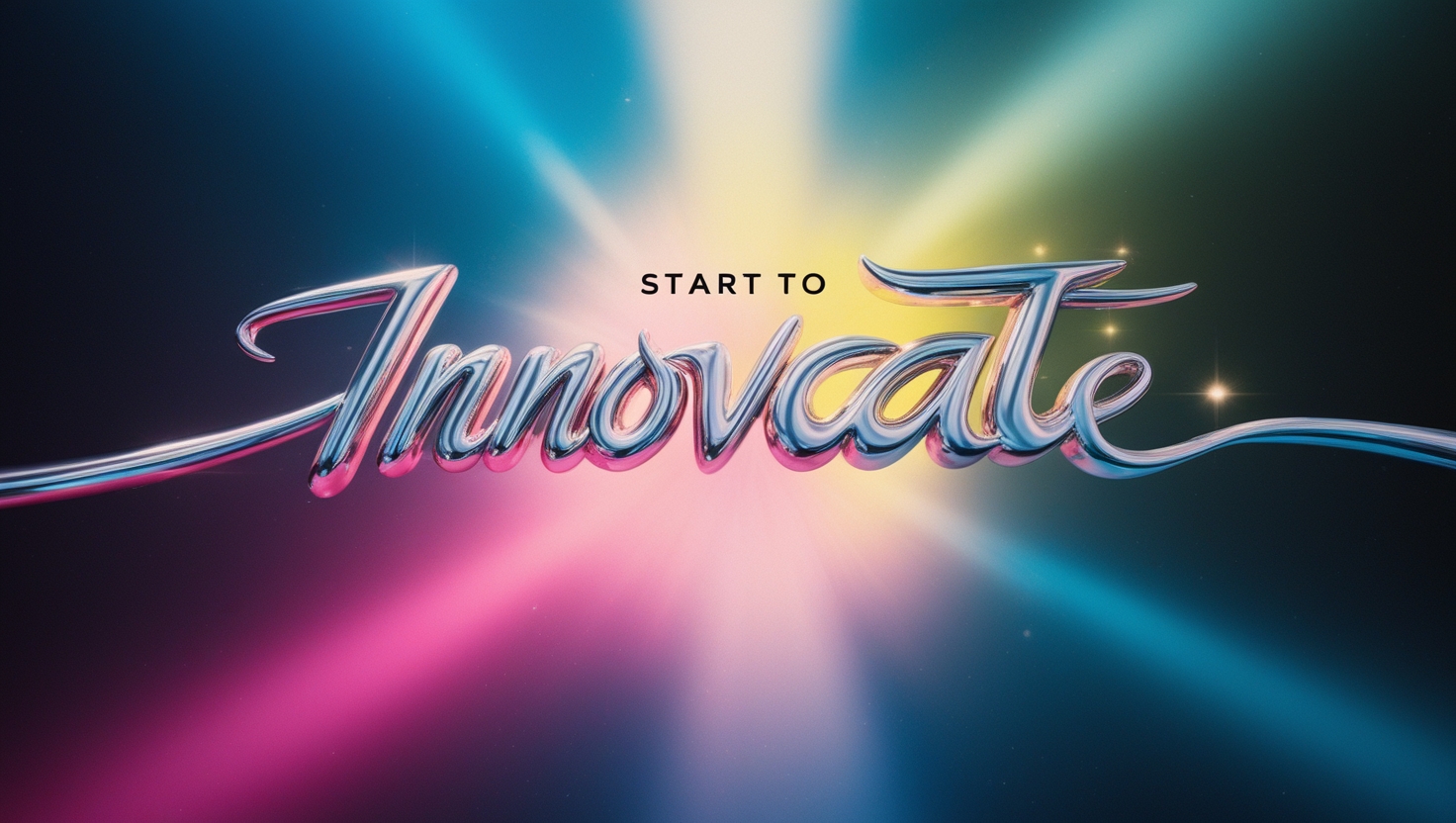Start to Innovate, Innovation may seem daunting, but it’s a process that can be approached with intention and creativity. Here are steps to help you begin innovating, no matter your field:
1. Change Your Perspective
- Question Assumptions: Begin by challenging the status quo. Question how things are done, why they are done that way, and whether there’s a better way to approach the problem. Look at situations from different angles and consider alternative methods.
- Seek Out New Experiences: Exposure to diverse environments, industries, or cultures can broaden your thinking. This can inspire fresh ideas that you can adapt and apply to your own work.
2. Identify Pain Points and Unmet Needs
- Observe and Listen: Pay close attention to the challenges people face or gaps in the market. What problems need solving? Innovation often arises from identifying pain points and finding creative solutions.
- Use Empathy: Put yourself in the shoes of others—whether they are customers, colleagues, or an audience. Understand their needs deeply to innovate solutions that resonate.
3. Combine and Remix Ideas
- Cross-Pollinate Concepts: Innovation doesn’t always come from inventing something entirely new. Sometimes, it’s about combining existing ideas in unique ways. Take inspiration from different industries, disciplines, or ideas and remix them into something that fits your domain.
- Mind Mapping: Visual brainstorming techniques, like mind mapping, help in exploring how different ideas can intersect or lead to unexpected innovations.
4. Prototype and Experiment
- Start Small: Innovation is about trial and error. Start by testing your ideas with small experiments, prototypes, or pilot projects. Don’t be afraid to fail—every failure is a learning opportunity that gets you closer to success.
- Iterate and Improve: Keep refining your ideas based on feedback, insights, or new discoveries. Continuous iteration ensures your innovations evolve over time and remain relevant.
5. Collaborate and Network
- Seek Out Diverse Input: Collaboration can spark innovation. Engage with people from various fields and backgrounds to get different perspectives. Often, fresh ideas emerge through collaborative thinking that challenges your assumptions.
- Mentors and Feedback: Find mentors or trusted colleagues to give you feedback. Sometimes, a new perspective or constructive criticism can push you toward a breakthrough.
6. Stay Curious and Keep Learning
- Be a Lifelong Learner: Innovation thrives on knowledge. Constantly seek to learn new skills, explore new technologies, or dive into new subject areas. The more you know, the more ideas you can pull from.
- Track Industry Trends: Stay updated on trends and advancements in your industry. However, don’t just follow them—think about how you can push beyond them.
7. Cultivate a Creative Mindset
- Embrace Playfulness: Innovation often happens when you allow yourself to experiment and think creatively, without fear of judgment. Take time to play with ideas, indulge in “what if” scenarios, and push the boundaries of conventional thinking.
- Overcome Perfectionism: Don’t wait for your ideas to be perfect. Innovation is a process, and it’s better to start with a rough version than to never start at all. Focus on getting your ideas out there, and improve them along the way.
8. Disrupt Yourself
- Step Out of Your Comfort Zone: Innovation often happens when you take risks or step into unfamiliar territory. Push yourself to explore new skills, approaches, or ideas that feel uncomfortable or uncertain.
- Embrace Change: Be willing to pivot or completely overhaul your thinking when necessary. Sometimes the most innovative ideas come when you’re open to disrupting your own way of doing things.
9. Leverage Technology and Tools
- Use Innovation Tools: Take advantage of technology or software that encourages innovation. From brainstorming apps to data analytics tools, there are countless resources that can help you innovate more efficiently.
- Automate the Routine: Free up mental space for creative thinking by automating repetitive tasks. The more time you spend on strategic and creative thinking, the more likely you are to come up with innovative ideas.
10. Develop Resilience
- Be Prepared for Setbacks: Innovation comes with risks, and not every idea will succeed. Develop a resilient mindset that sees setbacks as opportunities to learn and pivot. Staying persistent and adaptable is key to long-term innovation.
By starting small, staying curious, and continuously iterating, you can begin to innovate in meaningful ways that will distinguish you and your work from others.
Some Tips Towards innovation, whether you’re working individually or within a team:
1. Embrace Failure as Part of the Process
- Innovation rarely happens perfectly the first time. Accept that failure is a natural part of learning and growth. Treat each setback as a stepping stone to better solutions.
- Tip: Set up “safe spaces” for experimentation where failing fast and learning quickly is encouraged.
2. Think Outside Your Industry
- Sometimes the best innovations come from looking outside your own field. Borrow ideas from other industries and adapt them to your context.
- Tip: Study case studies or trends in unrelated sectors to spark new thinking. For example, how might a process from the automotive industry inspire innovation in healthcare?
3. Keep Asking “Why?”
- Continually ask questions like, “Why do we do it this way?” or “Why does this problem exist?” Digging deeper helps uncover root causes and opportunities for innovative solutions.
- Tip: Try the “Five Whys” technique—ask “Why?” five times in a row to get to the underlying issue or opportunity.
4. Focus on User-Centered Design
- Keep your end users or customers at the heart of your innovation process. Understanding their needs, behaviors, and pain points will help guide meaningful innovation.
- Tip: Use empathy mapping or conduct user interviews to gain deep insights into their experiences and challenges.
5. Encourage Cross-Functional Collaboration
- Innovative ideas often emerge when people with different skill sets, backgrounds, and perspectives work together. Diversity of thought leads to more creative solutions.
- Tip: Set up cross-functional brainstorming sessions, pairing engineers with marketers, or artists with data scientists.
6. Stay Open to Feedback and Iterate
- Innovation is a cycle, not a one-time event. Share your ideas early and often, and be open to feedback. Continuous improvement is key to evolving innovative ideas.
- Tip: Use rapid prototyping to test ideas quickly, gather feedback, and make improvements without over-investing time or resources.
7. Limitations Can Spark Creativity
- Constraints, like limited time or resources, often force more creative solutions. Instead of seeing limitations as roadblocks, view them as opportunities to innovate.
- Tip: Try setting artificial constraints on a project, such as a shorter timeline or a specific budget, to see how your team creatively solves problems.
8. Deconstruct and Rebuild
- Take an existing product, process, or service, and break it down into its individual components. Then think about how you could rearrange or modify these pieces to create something new.
- Tip: Use reverse engineering to dissect successful innovations and identify ways you can improve or remix their elements in novel ways.
9. Leverage Technology to Enhance Creativity
- Technology can accelerate the innovation process by automating routine tasks, providing insights through data, or enabling new ways of thinking.
- Tip: Experiment with AI, automation tools, or data analysis software to enhance creative processes and discover new opportunities.
10. Take Breaks to Refresh Creativity
- Innovation requires a rested and energized mind. Stepping away from a problem can often lead to breakthroughs when you’re least expecting it.
- Tip: Schedule regular breaks or “thinking time” away from work. Many innovators report that their best ideas come during downtime—while walking, exercising, or relaxing.
11. Prototype Boldly, But Start Small
- Don’t wait for perfection—test bold ideas quickly with minimal investment. Rapid prototyping allows you to gather insights and pivot faster.
- Tip: Build a low-cost mockup or digital prototype of your idea to visualize and test it with others before full development.
12. Incorporate Play and Curiosity
- Some of the best innovations come from playful experimentation. Allowing room for curiosity-driven exploration can lead to unexpected breakthroughs.
- Tip: Dedicate time to purely exploratory activities, without the pressure of specific outcomes. Creativity often emerges when people are given the freedom to “play.”
13. Create a Culture of Innovation
- If you’re working within a team or organization, it’s essential to foster an environment where innovation is encouraged and supported.
- Tip: Celebrate innovative ideas, even if they fail. Offer rewards or recognition for bold thinking and continuous improvement.
14. Follow Emerging Trends and Technologies
- Stay informed about the latest trends, tools, and advancements in your industry and beyond. Being an early adopter or adapting to trends can fuel innovation.
- Tip: Regularly read industry publications, attend webinars, or join innovation-focused groups to stay ahead of the curve.
15. Observe the Outliers
- Pay attention to outliers—companies, individuals, or products that stand out from the norm. These are often the ones disrupting the market or leading change.
- Tip: Study disruptors in your industry or others to understand what makes them different. What unconventional tactics or strategies are they using?
16. Document Your Ideas
- Inspiration can strike at any time. Make it a habit to jot down or document new ideas as soon as they come to you, no matter how undeveloped.
- Tip: Keep a notebook or use a note-taking app specifically for ideas. Revisit them periodically to see if they spark anything new.
By incorporating these tips into your routine, you’ll build a mindset that embraces innovation as an ongoing process and begin generating ideas that can truly stand out.
If you Liked Reading our Blog Read More Blogs Here and Below is the Link to our WhatsApp channel Join it for the Latest Post Updates. (Read For WhatsApp Channel Privacy and Security Here).
UseFull Resources:
| Resources | Resources |
|---|---|
| Tooldar: Tooldar | Hemingway Editor: Hemingway Editor |
| Ilovepdf3: Ilovepdf3 | Grammarly: Grammarly |
| Adorepdf: Adorepdf | Coursera: Coursera |
| Custom Design Agency: Articon Design Agency | Udemy: Udemy |
| Google: Google | Khan Academy: Khan Academy |
| Yandex: Yandex | Wolfram Alpha: Wolfram Alpha |
| Baidu: Baidu | TED Talks: TED Talks |
| Medium: Medium | Skillshare: Skillshare |
| Quora: Quora | Canva: Canva |
| Duolingo: Duolingo | Figma: Figma |
| Nerdfitness: Nerdfitness | Trello: Trello |
| DeepL: DeepL | Notion: Notion |
| LinkedIn: LinkedIn | Asana: Asana |
| Stack Overflow: Stack Overflow | Mailchimp: Mailchimp |
| GitHub: GitHub | Zapier: Zapier |
Note : These Above Resources Are just for Educational and ease of use Purposes we neither Endorse them, they were working at the time of sharing.
.Disclaimer: The information presented in this blog is for educational and informational purposes only and should not be considered financial, Political, or cultural advice. All efforts have been made to ensure the accuracy of the content at the time of writing.
Think We Missed Something?
If you notice an error or have a suggestion, we encourage you to submit a correction. Help us keep our information up-to-date and reliable!











